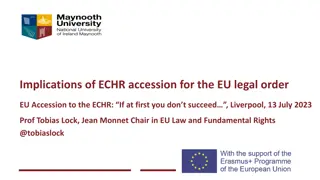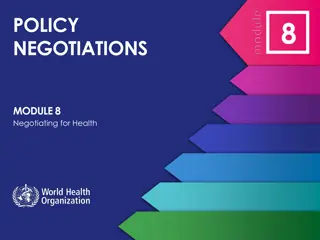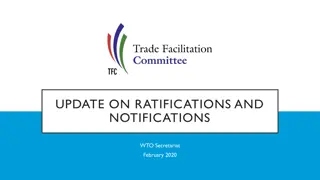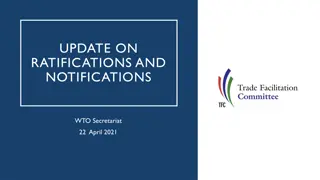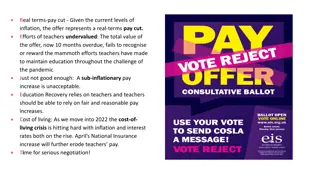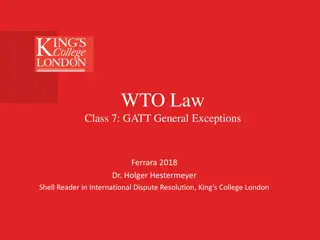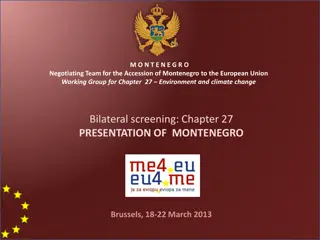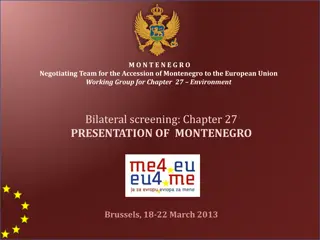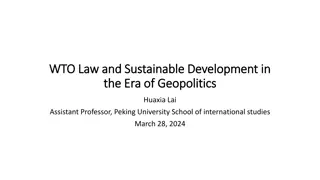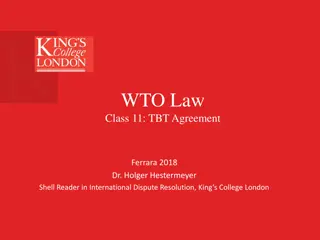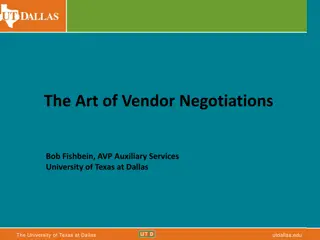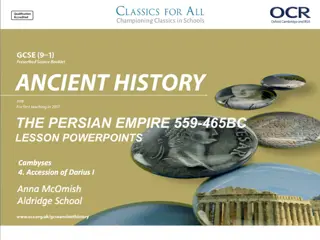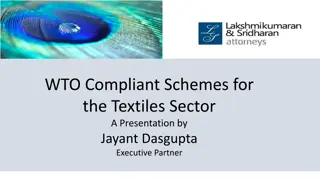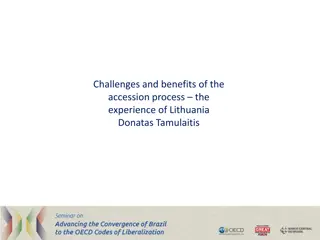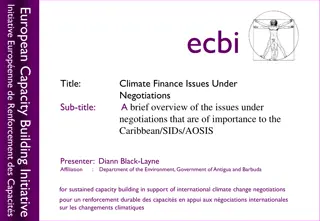Bilateral Negotiations in WTO Accession Process Overview
Learn about the key stages and rules of bilateral negotiations in the WTO accession process. Understand the importance of multiple revisions, regional concessions, and internal organization in negotiating market access. Discover the complexities of tariff negotiations, types of tariffs, and the strategic considerations involved in setting precedents for future accessions.
Download Presentation

Please find below an Image/Link to download the presentation.
The content on the website is provided AS IS for your information and personal use only. It may not be sold, licensed, or shared on other websites without obtaining consent from the author.If you encounter any issues during the download, it is possible that the publisher has removed the file from their server.
You are allowed to download the files provided on this website for personal or commercial use, subject to the condition that they are used lawfully. All files are the property of their respective owners.
The content on the website is provided AS IS for your information and personal use only. It may not be sold, licensed, or shared on other websites without obtaining consent from the author.
E N D
Presentation Transcript
Bilateral negotiations in the WTO accession process Presentation by Josip Pervan, Senior Policy Advisor IDEAS Centre, Geneva
The start ACC/1: initial offer in response to requests received,or on its own initiative In reality, most countries submit without receiving requests At least one (goods/services) is submitted prior to the second working party meeting. Subsequent offers submitted depending on the requests received.
The process Multiple revisions necessary At the beginning revisions tend to be multilateral, later on bilateral Bilateral revision- multiple selling of the same commitment Upon conclusion,bilateral protocols are signed At the end of the process, offers are consolidated into one schedule,which is offered on an MFN basis and verified by all members
Rulesof negotiations There is no standard offer the level of concessions is determined through negotiations Regional level of concessions plays a role Members ask for commercially meaningful market access including for future products Each accession sets precedents for future accessions (length of transition periods, use of safeguards, TQRs, etc.)
Internal organization Inter-ministerial groups at two-levels Consultative mechanism with the private sector Working groups for goods and services Agreeing on sensitivities, red lines Defining strategy Adapting as the negotiations progress- elaborating trade offs
15% bound duty level Goods negotiations Bound tariffs are the basis for negotiations Final bound rates close to applied levels Transition periods sensitive items Good arguments protection of tariffs Flexibility tools:transitional periods, special safeguard (SSG),tariff-rate quotas,specific duties accepted for needed for 5% applied duty level 0%
Types of tariffs Duty type Example 5% Ad valorem $5 per kg. Specific NAV 10% + $2 per kg Compound 10% or $2 per kg, which ever is highest Mixed
Format of the offer 1 2 3 4 5 6 7 HS number Description Bound rate at date accession Final bound rate Implementation period ODC INRs of In this column, refer to the HS numbers used by the acceding country in its tariff nomenclature Description of the product as indicated in the tariff nomenclatur e of the acceding country Bound rate at date of accession Bound rate after the implement ation period has elapsed Indicate the number of years after accession after which the bound rate will have to be reduced to the final bound rate indicated in column 4.1 Other duties and charges2 Initial negotiating rights 01011910 xxxx 18 10 5 0 x 1 Equal annual rate reductions, unless otherwise mentioned. 2Can be replaced by a headnote All ODCs are to be bound at zero.
Services Negotiations Schedule divided in sectors and modes of supply Concessions provided in market access and national treatment Horizontal and sectoral commitments Final bound commitments go beyond status quo Flexibilities: transitional periods, MFN exemptions, unbounding
SCHEDULE OF SPECIFIC COMMITMENTS OF COUNTRY X II. 1. BUSINESS SERVICES MA limitations NT limitations Additional commitments SECTOR SPECIFIC COMMITMENTS A. (a) Professional Services Legal Services (CPC861) Excluding legal advisory and legal documentation and certification services provided by services suppliers entrusted with public functions (the profession of notary is excluded from these commitments) (b) Accounting, auditing and bookkeeping services (CPC 862) (1) (2) (3) (4) Unbound. None. Unbound. Unbound. (1) (2) (3) (4) Unbound. None. Unbound. Unbound. (1) None for accounting and bookkeeping services; Unbound for auditing services. (2) None. (3) None. (4) Unbound, except as indicated in the horizontal section. (1) Unbound. (2) None. (3) None. (4) Unbound. (1) None for accounting and bookkeeping services; Unbound for auditing services. (2) None. (3) None. (4) Unbound, except as indicated in the horizontal section. (1) Unbound. (2) None. (3) None. (4) Unbound. (d) (e) (f) services Architectural services (CPC 8671) Engineering services (CPC 8672) Integrated engineering (CPC 8673) (1)Cross-border supply (2) Consumption abroad (3) Commercial presence (4) Presence of natural persons
Challenges in negotiations Typical developing country sensitivities: Typical regulatory challenges: Professional services Postal/courier services Telecom services Banking services Insurance services Road transport Land ownership Movement of Natural Persons Professional services Audio-visual services Construction services Distribution services Educational services Health services Movement of Natural Persons
Results: AG goods 120 100 80 60 40 20 0 Argentina Brazil Costa Rica India Indonesia Mexico South Africa Australia Canada European Union Japan Korea Switzerland United States China Croatia Kyrgyz Republic Mongolia Nepal Ukraine Viet Nam Russian F. Bound MFN applied
Results: ind. goods 50 40 30 20 10 0 Argentina Brazil Costa Rica India Indonesia Mexico South Africa Australia Canada European Union Japan Korea Switzerland United States China Croatia Kyrgyz Republic Mongolia Nepal Ukraine Viet Nam Russian F. Simple average Bound Simple average MFN applied
Binding coverage 100 90 80 70 60 50 40 30 20 10 0 Argentina Brazil Costa Rica India Indonesia Mexico South Africa Australia Canada European Union Japan Korea Switzerland United States China Croatia Kyrgyz Republic Mongolia Nepal Ukraine Viet Nam Russian F.
TRQs, SSGs Number of Tariff Rate Quotas Number of Tariff Lines with Tariff Rate Quotas Tariff Lines with Special Safeguards AG. PRODUCTS Croatia 9 9 0 (HS 4, 6, 8 digit level) Lithuania 4 4 0 (HS 4, 6, 8 digit level) Moldova 0 0 0 China 10 46 0 (HS 8 digit level) Chinese Taipei 22 117 32 (HS 8 digit level) (HS 8 digit level) Armenia 0 0 0 FYROM 1 1 0 (HS 10 digit level) Nepal 0 0 0 Cambodia 0 0 0 Saudi Arabia 0 0 0 Viet Nam 40 20
Sectoral initiatives Sectors Civil Aircraft Harmonizatio Pharmaceutic Construction Agricultural New Member (by date of accession) Equipment Equipment Equipment Agreement Chemical Furniture Distilled Medical Spirits Paper Steel Beer Toys ITA als n Ecuador Bulgaria Mongolia Panama Kyrgyz Rep. Latvia Estonia Jordan Georgia Albania Oman Croatia Lithuania Moldova China Chinese Taipei Armenia FYROM Nepal Cambodia Saudi Arabia Viet Nam Tonga Ukraine Cape Verde
Results: Services Recent examples (of 160 sub-sectors): Bulgaria December 1996 Kyrgyz Rep. April 1999 Albania September 2000 Georgia June 2000 Macedonia April 2003 Cambodia October 2004 Nepal April 2004 Vietnam January 2007 ~ 68 ~105 ~ 95 ~126 ~116 ~ 96 ~ 84 ~ 98
Original members vs newcomers Uruguay Round Participants Recent accessions 160 Number of sub-sectors committed 140 120 100 80 60 40 20 0 0 5000 10000 15000 GNP per capita USD (PPP) 2000 20000 25000 30000 35000 40000
Trends in the accession process Non- existence of rules makes the process unpredictable More difficult to acceede as the time goes by Development status plays a role Acceeding countries do not have much negotiating leverage Negotiators must keep in mind the global political and trade importance of their country Services negotiations- problem of coordination The problem of conflicting requests by WTO members (EU- USA) The position of Ukraine and / or other bilateral disputes The result: negotiations process ! are a time-consuming
THANK YOU josip.pervan@ideascentre.ch


